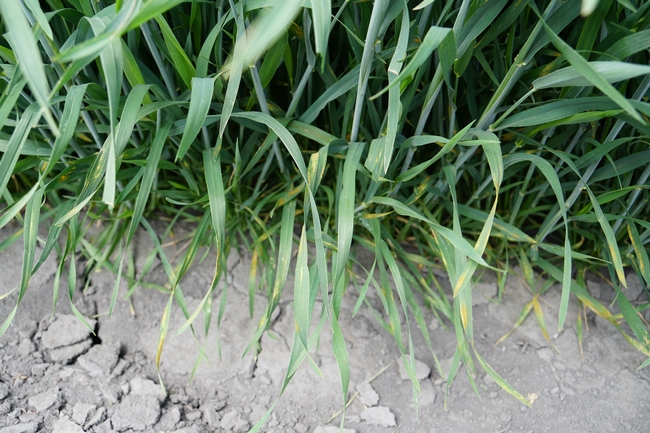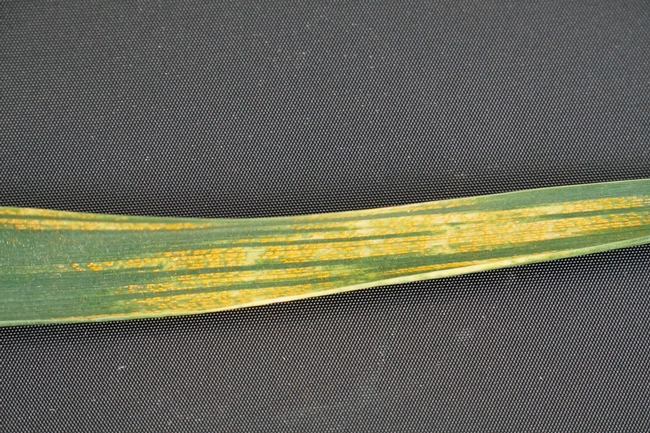The last couple of weeks we've received several reports from PCA's and wheat growers that many winter wheat, spring wheat, and barley fields have stripe rust. The widespread occurrence of stripe rust this early in the growing season is unusual for the Klamath Basin. The cool weather predicted for the next couple of weeks favors disease development and spread. Warm, dry weather on the other hand, is not favorable for stripe rust development. The Klamath Basin's warm, dry climate is a major reason stripe rust rarely causes significant yield loss in the Klamath Basin compared with other areas such as the Central Valley (where spring grains are grown over the winter) and the Willamette Valley. If Klamath Basin weather turns hot and dry in late June and July, stripe rust development will slow significantly. Unfortunately, conditions up to today suggest spring grain fields in the Klamath Basin may experience abnormally high stripe rust pressure this year.
In previous years with cool, wet springs, Klamath Basin growers and handlers reported yield losses in the neighborhood of 10% to 20%. In the Willamette Valley and other parts of California, stripe rust is more of a perennial problem and yield losses can exceed 20-40%. While we have not seen this level of yield loss in our area, it is within the realm of possibilities should the weather remain cool.
A common question asked by growers is whether fungicide treatment is recommended. This is a difficult question to answer. It depends on the wheat variety being grown, wheat prices, and future weather conditions. Many wheat breeders have developed varieties with stripe rust resistance. Wheat varieties with high stripe rust resistance will likely escape significant yield loss without fungicide application. Susceptible varieties like Tubbs or Yecora rojo will likely need a fungicide treatment to prevent yield loss. The economics of fungicides for stripe rust are dependent on fungicide choice and grain prices, but fungicide treatment will likely pay for itself and put more money in the growers pocket when stripe rust is widespread and susceptible varieties are grown under cool, wet weather conditions. Mike Flowers, Oregon State University Cereals Specialist, recently sent an email showing 2016 stripe rust severity ratings for many wheat varieties grown in the Willamette Valley. Mike's ratings and other publications are a great resource to review when selecting wheat varieties and when trying to determine a variety's susceptibility to stripe rust. Growers that plant Yecora rojo may want to consider planting a different hard red spring wheat variety next year. Recent IREC grain trials have shown newer varieties have higher yield potential, similar protein values, and often higher stripe rust resistance compared to Yecora rojo.
Foliar fungicides can effectively control stripe rust and protect wheat fields from significant yield loss. There hasn't been recent fungicide research on stripe rust in the Klamath Basin, but recommendations from other areas suggest fungicides should be applied when stripe rust symptoms are found in the field or the severity may become too severe for effective control. Fungicides are most effective when applied before stripe rust is severe. It is very important for fungicides to protect the flag leaf and upper leaves as these leaves contribute resources for grain fill. Products belonging to the strobilurin class of fungicides (Headline, Quadris) provide good activity against stripe rust but are most effective when applied before infection. If stripe rust is already present in the field at the time of fungicide application, many universities recommend use of a fungicide belonging to the triazole class of fungicides (Prosaro, Tilt). There are also several premixes that combine both fungicide classes (Quilt, Stratego). Always read the fungicide label and make sure to follow label instructions including using the recommended rate on the label. The number of fungicide applications needed is dependent on the level of infection and future weather conditions. Fungicide applications after 50% head emergence are too late in the growing season to provide a significant yield benefit and most fungicides are not labeled for use after grain head emergence.
Attached Files:
Attached Images:

